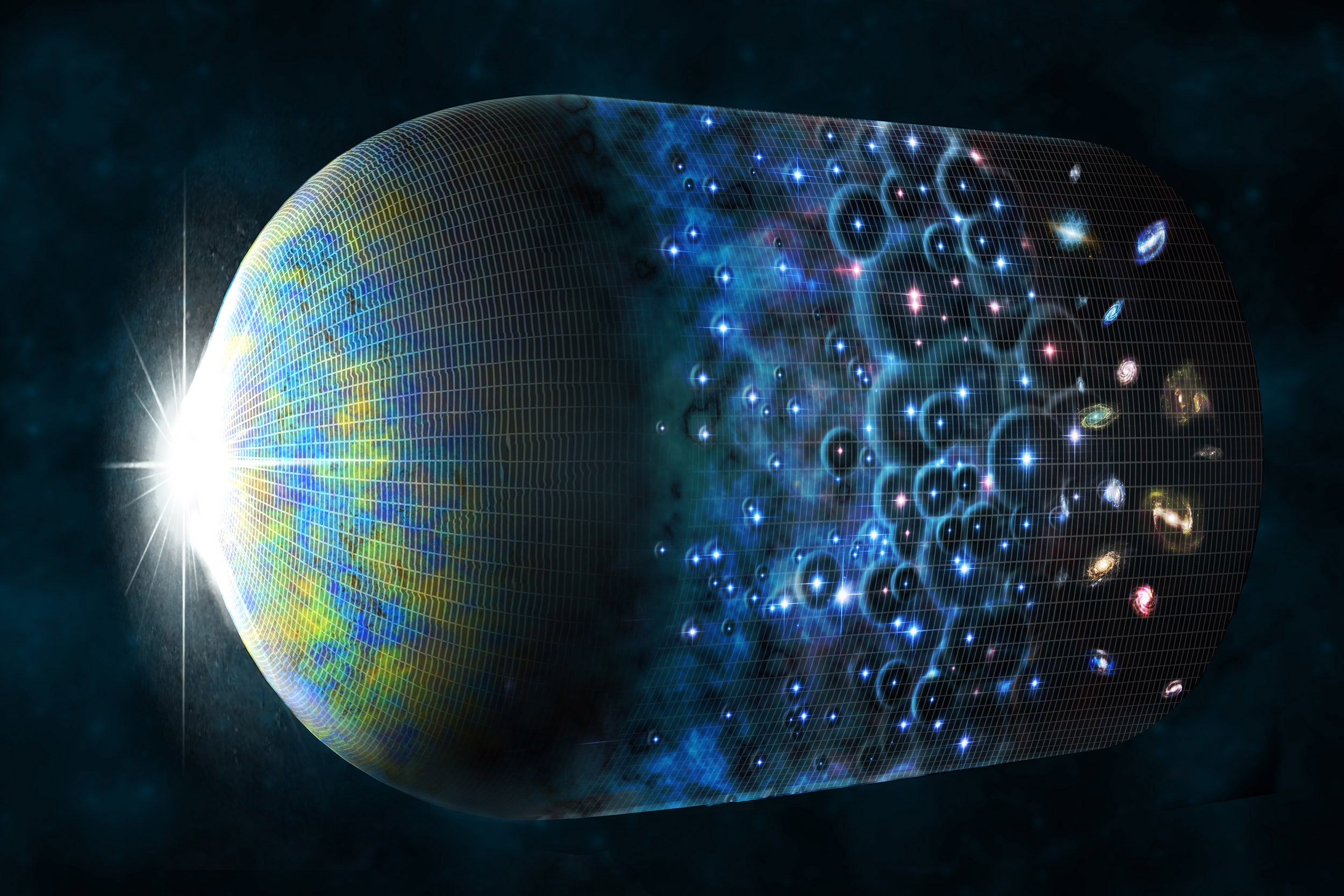
This artist’s impression shows the evolution of the universe, beginning with the Big Bang (left) and the appearance of the cosmic microwave background. The formation of the first stars ended the cosmic dark ages, followed by the formation of galaxies.
Artwork by M. Weiss/CfA
New light on dark matter
Researchers explain that dark matter particles may have electric charge, and why that matters
Astronomers are proposing a new model for the invisible material that makes up most of the universe: It is possible that a fraction of dark matter particles may have a tiny electrical charge.
“You’ve heard of electric cars and e-books, but now we are talking about electric dark matter,” said Julian Munoz, a postdoctoral fellow in the Department of Physics who led a new study published in the journal Nature. “However, this electric charge is on the very smallest of scales.”
Munoz and his collaborator, Avi Loeb of the Harvard-Smithsonian Center for Astrophysics (CfA), explored the possibility that charged dark matter particles interact with normal matter by electromagnetic force.
Their work dovetails with a recently announced result from the Experiment to Detect the Global EoR (Epoch of Reionization) Signature collaboration, known as EDGES. In February, scientists from this project said they had detected the radio signature, and possible evidence for interaction between dark matter and normal matter, from the first generation of stars.
Some astronomers quickly challenged the EDGES claim. Meanwhile, Munoz and Loeb were already looking at the theoretical basis underlying it.
“We’re able to tell a fundamental physics story with our research no matter how you interpret the EDGES result,” said Loeb, chair of the Harvard Astronomy Department and the Frank B. Baird Jr. Professor of Science. “The nature of dark matter is one of the biggest mysteries in science and we need to use any related new data to tackle it.”
The story begins with the first stars, which emitted ultraviolet light. According to the commonly accepted scenario, this UV light interacted with cold hydrogen atoms in gas between stars, and enabled the atoms to absorb the cosmic microwave background (CMB) radiation left over from the Big Bang.
“The nature of dark matter is one of the biggest mysteries in science and we need to use any related new data to tackle it.”
Avi Loeb of the CfA
This absorption should have led to a drop in intensity of the CMB during this period, less than 200 million years after the Big Bang. The EDGES team claims to detect evidence of this, though it has yet to be independently verified by other scientists. However, the temperature of the hydrogen gas in the EDGES data is about half of the expected value.
“If EDGES has detected cooler-than-expected hydrogen gas during this period, what could explain it?” said Munoz. “One possibility is that hydrogen was cooled by the dark matter.”
At the time when CMB radiation was being absorbed, any free electrons or protons associated with ordinary matter would have been moving at their slowest possible speeds (since they were heated later on by X-rays from the first black holes). Scattering charged particles is most effective at low speeds. Therefore, any interactions between normal matter and dark matter during this time would have been the strongest if some dark matter particles are charged. This interaction would cause the hydrogen gas to cool because the dark matter was cold, potentially leaving an observational signature such as that claimed by the EDGES project.
“We are constraining the possibility that dark matter particles carry a tiny electrical charge — equal to one-millionth that of an electron — through measurable signals from the cosmic dawn,” said Loeb. “Such tiny charges are impossible to observe even with the largest particle accelerators.”
Only small amounts of dark matter with weak electrical charge can both explain the EDGES data and agree with other observations. Were most dark matter charged, these particles would have been deflected away from regions close to the Milky Way and prevented from re-entering. This conflicts with observations showing large amounts of dark matter close to the disk of our galaxy.
Scientists know from observations of the CMB that protons and electrons combined in the early universe to form neutral atoms. Only a small fraction of these charged particles, about one in a few thousand, remained free. Munoz and Loeb are considering the possibility that dark matter may have acted in a similar way. The data from EDGES and similar experiments might be the only way to detect the few remaining charged particles, as most of the dark matter would be neutral.
“The viable parameter space for this scenario is quite constrained, but if confirmed by future observations, of course we would be learning something fundamental about the nature of dark matter, one of the biggest puzzles that we have in physics today,” said Harvard Assistant Professor Cora Dvorkin, who was not involved with the new study.
CfA’s Lincoln Greenhill is currently testing the EDGES team’s observational study. Greenhill leads the Large Aperture Experiment to Detect the Dark Ages (LEDA) project, which uses the Long Wavelength Array in Owen’s Valley, Calif., and Socorro, N.M.
The study appears in the May 31 issue of Nature.
This work was supported by the Dean’s Competitive Fund for Promising Scholarship at Harvard University, and by the Black Hole Initiative, which is funded by a grant from the John Templeton Foundation.




